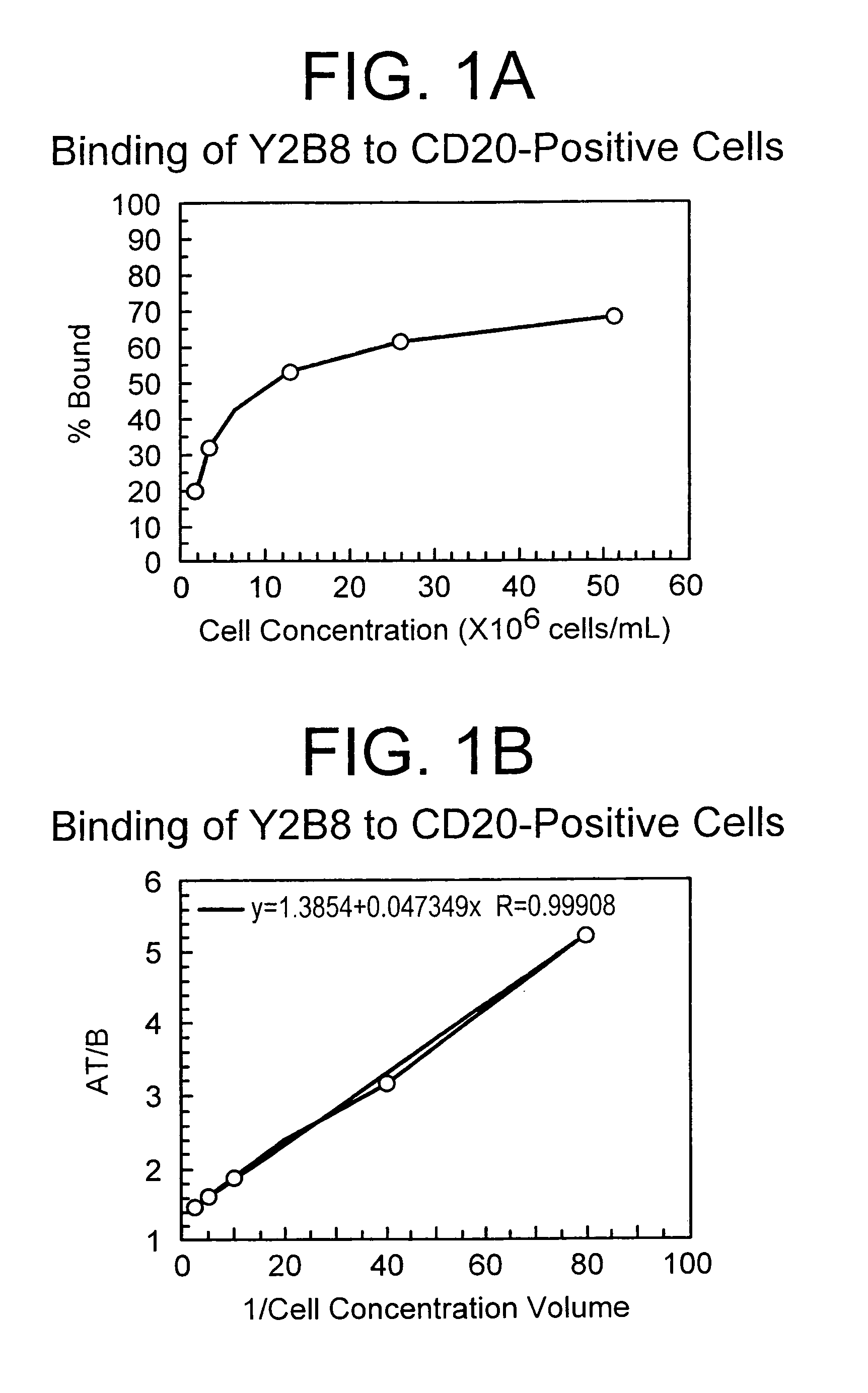Kit for radiolabeling ligands with yttrium-90
a technology of radiolabeling ligands and kits, which is applied in the field of kits and methods for radiolabeling proteins, peptides and ligands with therapeutic radioisotopes, can solve the problems of reducing the purity of the kit, reducing the efficiency of the killing agent, and reducing the efficiency of the therapeutic effect, etc., to achieve the effect of reducing the purity of the kit, reducing the cost of the kit, and improving the effect of safety
- Summary
- Abstract
- Description
- Claims
- Application Information
AI Technical Summary
Benefits of technology
Problems solved by technology
Method used
Image
Examples
example 1
Radiolabeling Kit and Method for Labeling 2B8 with 90Y
A. Reagents in Radiolabeling Kit
[0052]1. 2B8-MX-DTPA, IDEC; Lot# 082395RM2[0053]2. 50 mM Sodium Acetate, low-metal, IDEC; Lot# 082395RM3[0054]3. Formulation Buffer (1×PBS, pH 7.4 containing 7.5% (w / v) human serum albumin and 1 mM DTPA), IDEC, Lot# 082395RM1[0055]4. Reaction vial, 10 mL, IDEC
B. Materials and Equipment[0056]1. Biodex Tec-Control Radioincorporation Kit, Cat.#151–770[0057]2. Gloves: powder-free[0058]3. Sterile polypropylene syringes[0059]4. Sterile syringe needles[0060]5. Small tubes with closure; 1.5 ml
C. Methods
[0061]1. Preparation of Y2B8 Using Radiolabeling Kit
[0062]Kit reagents were prepared and filled into glass septum vials. Type I borosilicate vials (2 or 10 mL) were rinsed with sterile water for injection (WFI) and autoclaved before filling. Butyl rubber septa were rinsed with sterile WFI and autoclaved before use. Reagents were manually filled and crimped in a Class 100 room and tested for pyrogenicity and ...
example 2
Initial Evaluation of the Reaction Parameters—pH and reaction Time
[0128]Kinetic studies were initially performed to evaluate the radioincorporation and binding of the 90Y-labeled antibody (Y2B8) following labeling reactions performed under varying conditions of pH and reaction time. For radiolabeling reactions in the range of pH 3.9 to 4.7 at an incubation time of 5 min, radioincorporation was >96% with >80% retention of binding to CD20-positive cells (Table 2). Similar results were obtained for incubation times of 3, 5, and 10 min for the range of pH 2.9 to 4.6 (Table 3).
[0129]
TABLE 2Y2B8 Radiolabeling Kinetics: Effect of pH on Radioincorporationand Binding to CD20-Positive Cells1Reaction pHRadioincorporation (%)Binding (%)3.998.480.74.297.881.04.496.180.04.697.080.24.797.480.6
[0130]
TABLE 3Y2B8 Radiolabeling Kinetics: Effect of Incubation Time onRadioincorporation and Binding to CD20-Positive Cells1IncubationTime (min)Radioincorporation (%)Binding (%)pH 3.9:397.082.0598.982.11099.2...
example 3
Evaluation of Further Reaction Parameters
I. Introduction
[0132]Experiments described in this section examine the impact of protocol deviations on the binding of Y2B8 prepared using the Y2B8 Radiolabeling Kit. Binding of a radiolabeled antibody may be affected by several parameters during the radiolabeling process (Table 4).
[0133]
TABLE 4PredictedPredicted Effect onEffect onRadiolabeling Kit DeviationLabeling ConditionsBinding1.) Adding Excess Volume of 90Ydecrease pH;decreaseincrease radiolysis2.) Adding Less Volume of 90Yno change in pH;increase ordecrease radiolysisnone3.) Adding Excess Volume of NaAcno change in pH;increase ordecrease radiolysisnone4.) Adding Less Volume of NaAcdecrease pH;decreaseincrease radiolysis5.) Adding Excess Volume of 2B8-no change in pH;increaseMX-DTPAdecrease radiolysis(lower specificactivity)6.) Adding Less Volume of 2B8-MX-no change in pH;decreaseDTPAincrease radiolysis(higher specificactivity)7.) Incubating > 5 min.increase radiolysisdecrease8.) Incub...
PUM
| Property | Measurement | Unit |
|---|---|---|
| incubation time | aaaaa | aaaaa |
| temperature | aaaaa | aaaaa |
| temperature | aaaaa | aaaaa |
Abstract
Description
Claims
Application Information
 Login to View More
Login to View More - R&D
- Intellectual Property
- Life Sciences
- Materials
- Tech Scout
- Unparalleled Data Quality
- Higher Quality Content
- 60% Fewer Hallucinations
Browse by: Latest US Patents, China's latest patents, Technical Efficacy Thesaurus, Application Domain, Technology Topic, Popular Technical Reports.
© 2025 PatSnap. All rights reserved.Legal|Privacy policy|Modern Slavery Act Transparency Statement|Sitemap|About US| Contact US: help@patsnap.com



